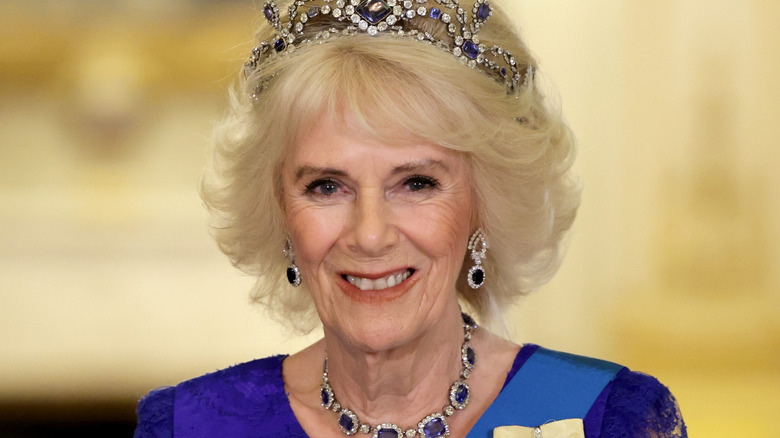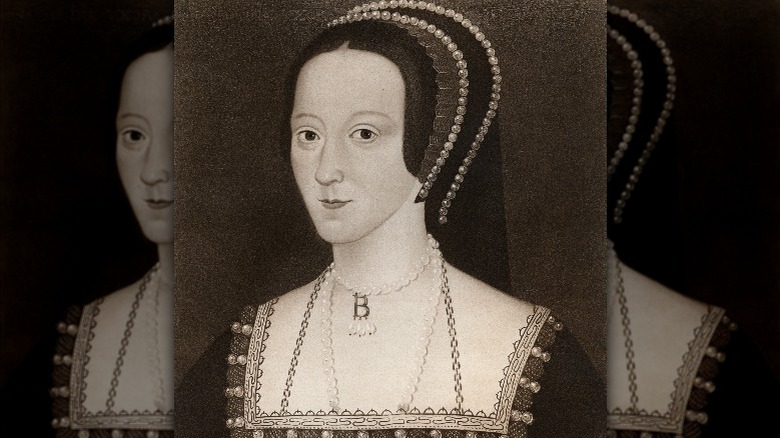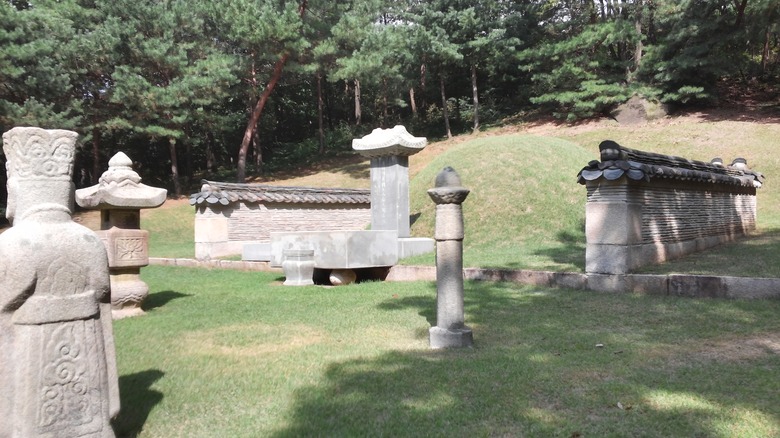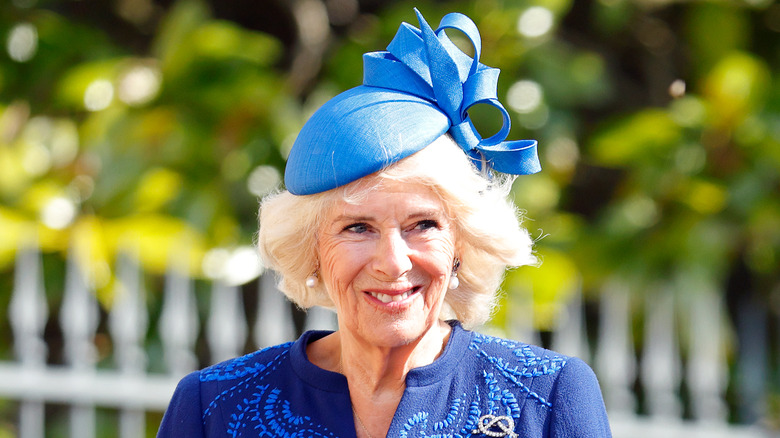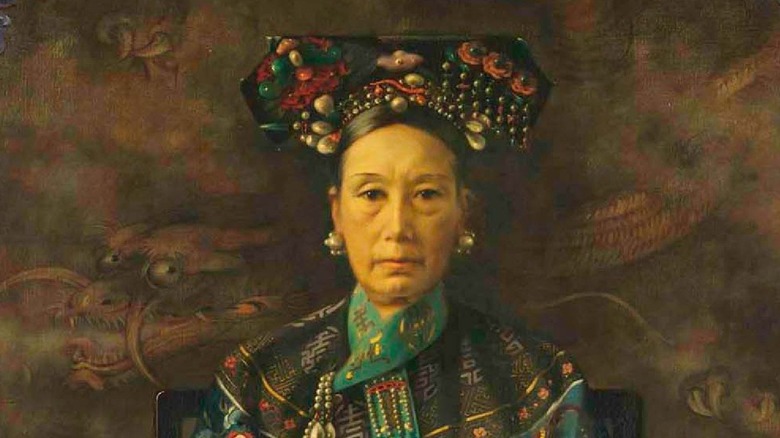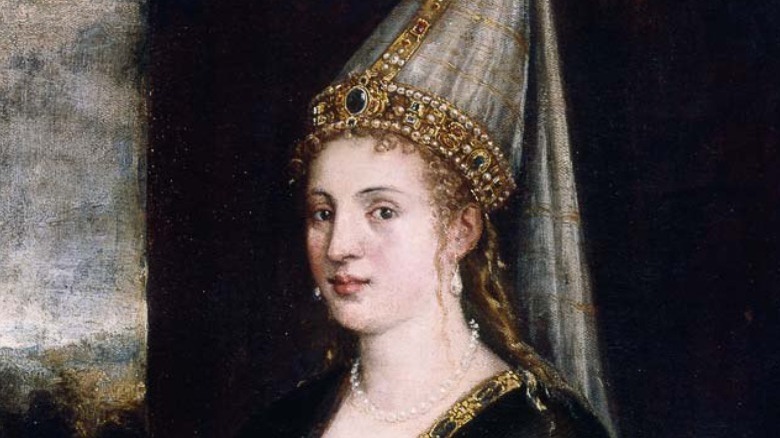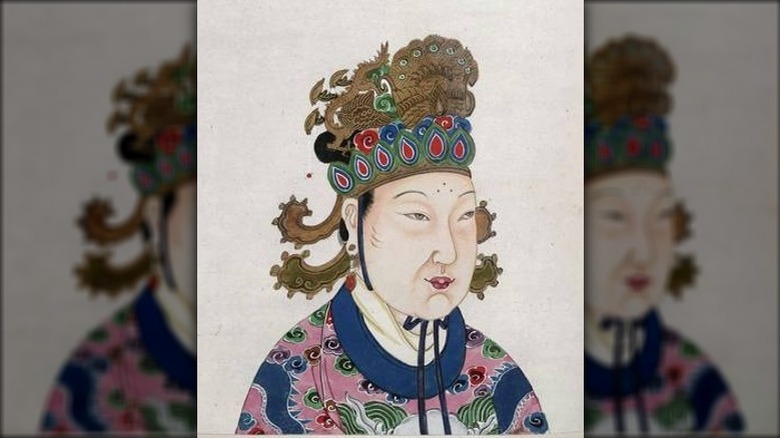Royal Mistresses And Concubines Throughout History Who Became Queen
The idea of going from the mistress of royalty to an actual royal position seems like a fairy tale story. But more often than not, catching the eye of a royal doesn't leave a person with much freedom to say no. It's easy for a king or an emperor to kidnap someone and force them to submit when they effectively make the law of the land.
Compared to her predecessors, the U.K.'s Queen Camilla is one of the lucky ones, having chosen her partner, King Charles III, in what's known as a love match and without the pressure of needing to produce an heir. Others have not been so lucky, but they still made what can arguably be described as the best out of a bad situation. Considering that their influence was tied to the presiding ruler at the time, it only made sense to seize the power themselves lest they be exiled or executed once their protector was dead. And that's what many women who were concubines ended up doing.
The idea of having a male heir was also important to several rulers throughout history, and women who were mistresses and concubines were often valued as long as they were able to produce a son. But even this wasn't always enough to save them. This is why royal power was intensely sought after. These are some royal mistresses and concubines throughout history who became queen.
Queen Anne Boleyn
Born around 1500, Anne Boleyn first showed up in the royal court of King Henry VIII of England in March 1522. Her sister Mary Boleyn was already a mistress of King Henry VIII, but although Henry became interested in Anne as well as her sister, Anne resisted his advances.
Time Magazine reports that Anne left the royal court in 1526 in a further attempt to avoid having to begin a relationship with the king and went to stay at her family home, Hever Castle. While she was away from the royal court, Henry wrote numerous letters to her making clear his obsession from at least May 1527 to October 1528. According to The Sheridan Libraries and University Museums, Henry is believed to have proposed marriage to Anne at some point in 1527. But no matter her answer, he was still technically married to Queen Catherine of Aragon and Pope Clement refused to grant him a divorce.
It took over six years for Henry VIII to come up with a solution. In 1533, he rejected Pope Clement VII's refusal to annul the marriage, started his own religion as the Supreme Head of the Church of England, divorced and banished Queen Catherine, and married Anne. But being crowned queen of England did little to protect Anne from the king's whims. Henry turned on Anne when she proved difficult, as well as failed to quickly birth to a living son. After she was found guilty of adultery in a sham trial, she was beheaded on May 19, 1536.
Royal Noble Consort Huibin Jang
Royal Noble Consort Huibin Jang, also known as Lady Jang, was born Jang Ok-jeong in 1659. Born to a middle-class family, Jang became a part of the royal court of King Sukjong of Joseon in Korea around the 1670s. It's not known exactly how Jang became a regular at the court, but it's believed to be related to her family's influence as translators.
According to "Women in Korean History" by Yi Pae-yong, King Sukjong quickly became enamored with Jang while married to Queen Inhyeon, his second wife. By 1688, Jang became pregnant and gave birth to a son, Gyun. Once King Sukjong had a son from Jang, he decided that he no longer had any use for Queen Inhyeon and expelled her from the royal court, revoking her royal status in 1689, not unlike what Henry VIII of England did to marry Anne Boleyn less than a century earlier, Asian Art Journal notes. Supporters of Queen Inhyeon were also deported and executed.
The same year Queen Inhyeon was expelled from the court, King Sukjong made Jang the Queen of Joseon. King Sukjong also acknowledged his son as an heir to the throne and made his son Prince Gyun. But the recognition of her son wouldn't save Queen Jang. In 1694, Queen Inhyeon was reinstated and Jang was stripped of her title. And when Queen Inhyeon died seven years later, King Sukjon blamed Jang for putting a curse on her and had her poisoned to death in 1701.
[Featured image by KoreanHistoryWriter via Wikimedia Commons | Cropped and scaled | CC BY-SA 3.0]
Queen Consort Camilla
The most recent mistress-turned-royalty is the former Camilla Rosemary Shand, also known as Camilla Parker Bowles, who became the Queen Consort of the United Kingdom on September 8, 2022. Camilla was born on July 17, 1947, to a wealthy family of British aristocrats. And being a mistress even runs in the family, as Camilla's great-grandmother, Alice Keppel, was a favorite mistress of King Edward VII.
Camilla first met Charles through a mutual friend in 1971, according to "The Duchess" by Penny Junor (per Vogue), and they started seeing each other by the following year. However, Camilla was also seeing Andrew Parker Bowles, whom she would later marry. Prince Charles married Diana Frances Spencer, later Diana, Princess of Wales, in 1981, and briefly stopped seeing Camilla but remained attached. Time Magazine reports that Charles even bought Camilla a personalized bracelet right before the wedding and wore cufflinks from her on his honeymoon. Prince Charles and Camilla resumed their affair in 1986 and continued to see each other throughout the rest of Prince Charles's marriage to Diana.
In 1995, Camilla divorced her husband and Prince Charles divorced Princess Diana the following year. They began seeing each other publicly within five years and in April 2005, Prince Charles and Camilla were officially married, with Camilla becoming known as the Duchess of Cornwall. Upon the death of Queen Elizabeth II, Camila assumed the title of Queen Consort as Prince Charles became King Charles III of the United Kingdom.
Empress Dowager Cixi
Considered to be the most powerful empress in the history of China, Cixi was once just one of the emperor's many concubines. Born Yehe Nara Xingzhen in 1835 to a family of government officials in China, Cixi was taken to be a concubine Xianfeng Emperor, also known as Emperor Wenzong of Qing, when she was just 16 years old. According to The Guardian, Cixi was initially a lower-rank concubine, but she became more highly regarded after she had a son, Zaichun.
After the death of Xianfeng Emperor, Cixi joined forces with Empress Dowager Zhen, who had also previously been a concubine, and the pair launched a coup to take control of the empire. Cixi and Empress Dowager Zhen ruled together until Zhen died in 1881, at which point Cixi became the sole ruler of China as Empress Dowager.
Throughout this time Empress Dowager Cixi had installed her son as Tongzhi Emperor, but because he was young she was able to rule in his stead as regent. Tongzhi Emperor was able to gain back his formal power when he was 17, but after his untimely death two years later, Cixi took back control as regent while her four-year-old nephew became Guangxu Emperor, according to the Smithsonian Institute. She continued to install young male relatives as emperor – and is even believed to have murdered Guangxu Emperor to do so — for the rest of her life until her death in 1908 at the age of 73.
Haseki Hurrem Sultan
Little is known about Hurrem Haseki Sultan's early life. Even her original name is unknown, though it's believed to be Anastasia or Alexandra Lisowska. Hurrem was born around 1505 in the Kingdom of Poland, and when she was less than 15 years old, she was kidnapped by Crimean Tatars who raided her village. She was subsequently trafficked to Constantinople in the Ottoman Empire to be sold into sexual slavery.
The Collector writes that in Constantinople, Hurrem was reportedly purchased by Pargali Ibrahim Pasha, who gave her to Sultan Suleiman I as a gift around 1520. In Sultan Süleyman's harem, Hurrem was given the name Roxelana, which translates to "maid from Ruthenia."
In 1521, Hurrem gave birth to a son, which was the second son of Sultan Süleyman. According to "The Ottoman Empire, 1300-1650" by Colin Imber, this typically would've meant that the sultan ceased seeing the mother of his son. But Süleyman continued to see Hurrem and had six more children with her. In 1533, Sultan Süleyman married Hurrem, making her Sultan, and freed her from living in the harem. Hurrem lived in Topkapi Palace for the rest of her life until her death in April 1558 and became known for her patronage of the arts and many charitable projects.
If you or anyone you know has been a victim of sexual assault, help is available. Visit the Rape, Abuse & Incest National Network website or contact RAINN's National Helpline at 1-800-656-HOPE (4673).
Empress Consort Wu Zetian
Wu Zetian is one of the earliest women to move from being a concubine to the highest seat of power. Born in 624 in Tang China, Wu is believed to have been born into an aristocratic merchant family, and in "The World of Wu Zhao," N. Harry Rothschild writes that she became Emperor Taizong's concubine at the age of 14 when her father died.
According to the Association for Asian Studies, when Wu first became a concubine she was made a fifth-rank concubine, a fairly low level. After Emperor Taizong died, Wu became a Buddhist nun, as was required of all royal consorts. But the new Emperor Gaozong had become enamored with Wu while she was Taizong's concubine and he was then-Prince Li Zhi, and brought her back to the royal court from the temple. But this time, Wu was made second-rank concubine.
At this time, Emperor Gaozong was married to Empress Wang and had another favored concubine, Xiao. But Wu continued to win his favor, especially after having several sons by him. And Smithsonian Magazine writes that Wu possibly consolidated her power by accusing both Empress Wang and Xiao of infanticide, resulting in their executions, although the veracity of these stories is debatable. But once they were gone, Wu became Empress Wu. After Emperor Gaozong lost his eyesight in 660, Empress Wu took over the Tang dynasty, even making decisions when her sons were supposed to be ruling, until she was overthrown in 705.
